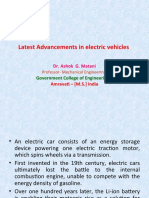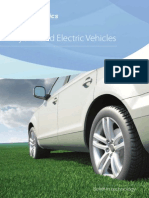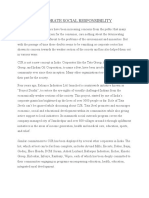Lubrication in EVs
Lubrication in EVs
Uploaded by
Sona DuttaCopyright:
Available Formats
Lubrication in EVs
Lubrication in EVs
Uploaded by
Sona DuttaCopyright
Available Formats
Share this document
Did you find this document useful?
Is this content inappropriate?
Copyright:
Available Formats
Lubrication in EVs
Lubrication in EVs
Uploaded by
Sona DuttaCopyright:
Available Formats
FUCHS
Electric cars – new technology calls for new lubrication
Altered behaviors
a look at vehicle statistics shows that China, the USA and Japan are the biggest markets for
plug-in hybrids and completely electric cars. In 2016, the number of such cars in the world was
estimated at just over 2 million. Growth was 60% and the highest increase was in China, which
accounted for 40% of sales. Despite this, electric cars account for just 0.2% of the worldwide
fleet of light vehicles. Norway is an exception and is often referred to as the primary electric car
nation, mainly due to the preferential subsidies. In 2016, electric cars had a market share of
29% in Norway. The Netherlands was in second place with just over 6%, followed by Sweden
with a market share for electric cars of around 3.5% in 2016.
New technology – new lubrication (HYBRID CARS)
Hybrid cars still have a small combustion engine that extends the vehicle’s range, as well as a
partially electric drivetrain.
The combustion engine in a hybrid car will still need lubrication. This engine will have a smaller
displacement since it also has an electric motor, and will not need to produce all the power as in
a conventional vehicle.
“With a smaller displacement, requirements for heat and ageing stability will increase. This is
because more compact engines are also more encapsulated which stresses the engine oil
further,” says Garb.
In smaller engines with high power, a turbocharger is often used today. This increases the need
for protection against deposits and places very high demands on the oil.
Whole new demands (EVs)
“As the future entails more completely electric vehicles, the development of engine oil must
continue.
When the development of completely electric vehicles intensifies, other product groups will also
be affected. Whole new demands will be placed on gear oils, coolants and greases, partly
because they will be in contact with electric modules, sensors and circuits, and will be affected
by electrical current and electromagnetic fields.
“The lubricants must be compatible with everything from copper wires and electric modules to
special plastics and insulation materials. This means they will have to be more specialized to
cope with lubrication in these environments,” Garb continues.
Moreover, motors in electric cars also emit a lot of heat, which will need to be led away from the
electric module. Here, effective cooling concepts will be increasingly important. It is also likely
that the electric motors will be driven at higher and higher speeds in order to increase efficiency.
Already brand new motors are being designed, and different lubrication and cooling concepts
are being discussed. With high-speed electric motors, the RPM in the drivetrain will need to
decrease. New reduction gears with less gear steps are therefore being implemented, with
potentially higher input speeds.
Since the reduction gears can be combined with electric modules, their gear oils too must work
well with the chosen module materials. This transition is a major challenge for developers of
lubricants, since it entails a considerable change in lubricant specifications.
TOTAL-
Lubricating electric vehicles
Electric vehicles need lubricants that can meet the specific requirements of their
powertrains. By launching a dedicated range, Total is again pioneering and cementing its
ambition to be a leader in electric mobility.
Electric cars reshuffle the deck in the automotive market
Passenger car electrification is here to stay. By the 2040s-2050s, the propulsion systems —
from all-electric to hybrid — used by vehicles on the road worldwide will be totally different.
Four key factors are driving the change:
Cheaper batteries, whose price is expected to drop another 67 percent by 2030[1], cutting
the cost of a battery pack kilowatt-hour to $100 from $209 at the end of 2017.
An increasing number of policy decisions to banish internal combustion engines (ICE)
from cities, especially in China, for public health reasons.
Automakers, all of which are planning to halt technological development of internal
combustion engines.
Electric cars that already offer the full range of comfort, convenience, enjoyment and
modularity, while alleviating anxiety about running out of power thanks to more efficient
batteries.
Lubricants designed for EVs
Lubricating an internal combustion engine is very different from the same job for an EV motor.
The former needs both oil to minimize engine friction and transmission fluid. These products are
different. Engine oils in particular degrade over their lifetime as combustion gases contaminate
them, meaning they have to be replaced regularly.
Electric vehicles experience significant fluctuations in power flows and high motor speeds of up
to 15,000 revolutions a minute. They can require several fluids: oil for the gear reducer, which is
the EV's transmission, and an oil specifically for the electric motor if the automaker is trying to
improve cooling. Thermal management fluids for the battery and power electronics will be
coming in the near future to support fast charging and strong acceleration in order to increase
range and ensure safety.
"These fluids, which are exposed to high voltages, have very specific properties," says François
Bénard, prospective & innovation manager at Total Lubricants. "They're subjected to high
temperatures and must protect key components, such as coils, from corrosion while preventing
short circuits. The vehicle's lifetime and safety depend on it."
You might also like
- 2023 COP28 ZEV FactbookDocument71 pages2023 COP28 ZEV FactbookSimon Alvarez100% (1)
- Hybrid Electric VehiclesDocument6 pagesHybrid Electric VehiclesIslam FattouhNo ratings yet
- Information About Electric VehiclesDocument56 pagesInformation About Electric VehiclespasistNo ratings yet
- The Future of LubricantsDocument8 pagesThe Future of LubricantssrcattozziNo ratings yet
- Assignment Oumh2103 English For Science Technical PurposesDocument12 pagesAssignment Oumh2103 English For Science Technical PurposesKhairul AnuarNo ratings yet
- Hybrid Electric Vehicles 1Document5 pagesHybrid Electric Vehicles 1Narendra JangidNo ratings yet
- Electric Cars Disruptive Innovation in The Indian Auto IndustryDocument3 pagesElectric Cars Disruptive Innovation in The Indian Auto IndustryEditor IJTSRDNo ratings yet
- Notes On Electric VehiclesDocument60 pagesNotes On Electric VehiclesSiadenda100% (1)
- Assignment On Innovation ManagmentDocument5 pagesAssignment On Innovation ManagmentSanthoshNo ratings yet
- Thesis Statement For Electric CarsDocument6 pagesThesis Statement For Electric Carsafkoliddh100% (2)
- Electric VehiclesDocument38 pagesElectric Vehiclespanthaayushma601No ratings yet
- Hybrid Car ThesisDocument7 pagesHybrid Car Thesisfc2frpq5100% (2)
- Hybrid Vehicle ThesisDocument5 pagesHybrid Vehicle Thesisdnr8hw9w100% (2)
- DR Matani - Latest Advancements in Electric Vehicles (2) (1) (PDocument33 pagesDR Matani - Latest Advancements in Electric Vehicles (2) (1) (PRk Sharma100% (1)
- Hybrid Electric-VehiclesDocument9 pagesHybrid Electric-Vehicles2023isjsuhasbNo ratings yet
- Review On Electric Vehicles: Sumathy Muniamuthu, Krishna Arjun. S, Jalapathy. M, Harikrishnan. S, Vignesh. ADocument10 pagesReview On Electric Vehicles: Sumathy Muniamuthu, Krishna Arjun. S, Jalapathy. M, Harikrishnan. S, Vignesh. ATJPRC PublicationsNo ratings yet
- Technical Challenges of Deploying Electric VehiclesDocument4 pagesTechnical Challenges of Deploying Electric VehiclesMei QiiNo ratings yet
- Electric VehicleDocument64 pagesElectric VehiclekolamanasvithaNo ratings yet
- Low-Pollution Three-Wheeler Autorickshaw With Power-Assist Series Hybrid and Novel Variable DC-link Voltage SystemDocument14 pagesLow-Pollution Three-Wheeler Autorickshaw With Power-Assist Series Hybrid and Novel Variable DC-link Voltage SystemhodvmkvecautoNo ratings yet
- Pdf-To-Word Om SRIDocument18 pagesPdf-To-Word Om SRIDixith NagarajanNo ratings yet
- Review On Electric VehiclesDocument11 pagesReview On Electric VehiclesKen AdamsNo ratings yet
- CHAP 1 FinalDocument30 pagesCHAP 1 Finalphebe vargheseNo ratings yet
- The Present and Future of Hybrid and Electric VehiclesDocument12 pagesThe Present and Future of Hybrid and Electric VehiclesrajmehaNo ratings yet
- Hybrid Cars: Name-Kshitij Sharma ROLL NO-130106083 Class - Mechanical "A"Document26 pagesHybrid Cars: Name-Kshitij Sharma ROLL NO-130106083 Class - Mechanical "A"ksharma294No ratings yet
- TT Hybrid BrochureDocument12 pagesTT Hybrid BrochurepapipapiiNo ratings yet
- Hybrid Vehicles ThesisDocument7 pagesHybrid Vehicles Thesisbethhernandezpeoria100% (2)
- End ReviewDocument17 pagesEnd ReviewNishant DuggedNo ratings yet
- Review_on_Electric_VehiclesDocument11 pagesReview_on_Electric_VehiclesPhạm Hải ĐăngNo ratings yet
- Hybrid Vehicles (SAISH GAONKAR)Document16 pagesHybrid Vehicles (SAISH GAONKAR)PrathameshNo ratings yet
- By: Pravin Kumar JaisawalDocument22 pagesBy: Pravin Kumar JaisawalJaisawal PravinNo ratings yet
- Mel713 - Design of I.C. Engines: Components & Sub-SystemsDocument9 pagesMel713 - Design of I.C. Engines: Components & Sub-SystemsAbhik PaulNo ratings yet
- Electric Car Thesis StatementDocument7 pagesElectric Car Thesis Statementveronicamorseaurora100% (2)
- Hybrid Car: A National Level Technical SymposiumDocument15 pagesHybrid Car: A National Level Technical SymposiummicmechNo ratings yet
- Hybrid Car Literature ReviewDocument6 pagesHybrid Car Literature Reviewea5hdhzn100% (1)
- Summative Part 1Document6 pagesSummative Part 1taranbinning1No ratings yet
- Electric Motor Production BusinessDocument76 pagesElectric Motor Production Businessold man need subscribersNo ratings yet
- Q1: Do A Detailed Secondary Data Analysis About Conversion Kits, Its Potential, Range, Current Suppliers, and Other Related IssuesDocument7 pagesQ1: Do A Detailed Secondary Data Analysis About Conversion Kits, Its Potential, Range, Current Suppliers, and Other Related IssuesTemporary AccountNo ratings yet
- Electric Cars vs non electric cars by ninto manguish khokarDocument5 pagesElectric Cars vs non electric cars by ninto manguish khokarwaleed.mohid.icsNo ratings yet
- McKinsey Recharging Chinas Electric Vehicle AspirationsDocument20 pagesMcKinsey Recharging Chinas Electric Vehicle AspirationspasistNo ratings yet
- Alternate Fuels For Automobiles by M A QadeerDocument175 pagesAlternate Fuels For Automobiles by M A QadeerAbdul Qadeer SiddiquiNo ratings yet
- Design and Fabrication of Fuel Free Electric Car For Seating 2 Passenger.Document55 pagesDesign and Fabrication of Fuel Free Electric Car For Seating 2 Passenger.Mohammad Iftikhar AhmedNo ratings yet
- Emissions in Life Cycle of Electric VehicleDocument12 pagesEmissions in Life Cycle of Electric VehicleJungaveni SruthilayaNo ratings yet
- Transition To Electric VehiclesDocument13 pagesTransition To Electric VehiclesShreyashi Haldar100% (1)
- Arun A Green Energy - Battery Operated VehicleDocument7 pagesArun A Green Energy - Battery Operated VehicleDinesh DinuNo ratings yet
- The Present and Future of Hybrid and Electric VehiclesDocument12 pagesThe Present and Future of Hybrid and Electric VehiclesvishiwizardNo ratings yet
- Unit 2 - HEVDocument54 pagesUnit 2 - HEVsavitaNo ratings yet
- University of Benghazi Faculty of Information Technology: Submitted byDocument9 pagesUniversity of Benghazi Faculty of Information Technology: Submitted byOsama AlarafeeNo ratings yet
- Electric Car Craze PDFDocument25 pagesElectric Car Craze PDFdakkid100% (1)
- Hybrid Synergy DriveDocument36 pagesHybrid Synergy DriveRohan Shivasundar100% (1)
- 6.hybrid VehicleDocument12 pages6.hybrid VehicleawesomeyogeshwarNo ratings yet
- DROC Bearing MarketDocument3 pagesDROC Bearing MarketRishov MondalNo ratings yet
- Minor Project Feasibility of Ev in IndiaDocument12 pagesMinor Project Feasibility of Ev in IndiaHarsh ChaudharyNo ratings yet
- Fev Unit IiiDocument31 pagesFev Unit IiiYuva TejaNo ratings yet
- Engg EconDocument15 pagesEngg EconJom AmbaganNo ratings yet
- Battery Car Model 6000Document4 pagesBattery Car Model 6000Nagesh VettiNo ratings yet
- Electric Motor VehiclesDocument19 pagesElectric Motor VehiclesAmisha SharonNo ratings yet
- English ReportDocument20 pagesEnglish ReportAakashNo ratings yet
- The Economics of Electric Vehicles in IndiaDocument5 pagesThe Economics of Electric Vehicles in IndiaPriyanshu KumarNo ratings yet
- SEMINARon Hybrid CarDocument19 pagesSEMINARon Hybrid CarAnkita SinghNo ratings yet
- Research Electric CarsDocument3 pagesResearch Electric CarsAzka IhsanNo ratings yet
- HFC Hydrogen Fuel Cell Cars: The Next Generation in Electric CarsFrom EverandHFC Hydrogen Fuel Cell Cars: The Next Generation in Electric CarsNo ratings yet
- Indian EconomyDocument2 pagesIndian EconomySona DuttaNo ratings yet
- Manu. Process and ThermoDocument10 pagesManu. Process and ThermoSona DuttaNo ratings yet
- Passenger Cars Industry Trend 18-19Document7 pagesPassenger Cars Industry Trend 18-19Sona DuttaNo ratings yet
- Major Manufacturing Facilities: Collaboration / Technical Tie-UpsDocument11 pagesMajor Manufacturing Facilities: Collaboration / Technical Tie-UpsSona DuttaNo ratings yet
- Indian EconomyDocument2 pagesIndian EconomySona DuttaNo ratings yet
- NIT Sil DetailDocument1 pageNIT Sil DetailSona DuttaNo ratings yet
- National Election ScheduleDocument2 pagesNational Election ScheduleSona DuttaNo ratings yet
- Packages With A Total of 14 Items. The Contracted Prices of 7 Items Were Higher Than The "Aligned Price", TheDocument1 pagePackages With A Total of 14 Items. The Contracted Prices of 7 Items Were Higher Than The "Aligned Price", TheSona DuttaNo ratings yet
- Indian EconomyDocument2 pagesIndian EconomySona DuttaNo ratings yet
- Gen X Vs Gen YDocument3 pagesGen X Vs Gen YSona DuttaNo ratings yet
- How Shock Absorber WorksDocument3 pagesHow Shock Absorber WorksSona DuttaNo ratings yet
- Engg. Q From TIMEDocument15 pagesEngg. Q From TIMESona DuttaNo ratings yet
- Farm Loan Waivers - Good or BadDocument2 pagesFarm Loan Waivers - Good or BadSona DuttaNo ratings yet
- CSR - Source MBA RendezvousDocument3 pagesCSR - Source MBA RendezvousSona DuttaNo ratings yet
- Castrol India Limited: Statement of Audited Financial Results For The Quarter and Year Ended 31 December 2018Document3 pagesCastrol India Limited: Statement of Audited Financial Results For The Quarter and Year Ended 31 December 2018Sona DuttaNo ratings yet
- Data Is The New OilDocument1 pageData Is The New OilSona DuttaNo ratings yet
- Digital Payments in IndiaDocument3 pagesDigital Payments in IndiaSona DuttaNo ratings yet
- Is MBA A Rat RaceDocument1 pageIs MBA A Rat RaceSona DuttaNo ratings yet
- UAMSymposium Bertram Final ElibDocument10 pagesUAMSymposium Bertram Final ElibGulshan BajajNo ratings yet
- Electric: Hybrid Abbreviated HEV, Is Combustion andDocument36 pagesElectric: Hybrid Abbreviated HEV, Is Combustion andDheeraj kumarNo ratings yet
- Toyota Vikas Auto SalesDocument106 pagesToyota Vikas Auto Salesnaina905812No ratings yet
- Basics of Hybrid Electric VehiclesDocument2 pagesBasics of Hybrid Electric VehiclesSumanranuNo ratings yet
- Electric Vehicle For Traction MotorsDocument12 pagesElectric Vehicle For Traction Motorschetan_harsha_1100% (1)
- Airvolt TestDocument22 pagesAirvolt Testadam_tomasNo ratings yet
- Reducing Fuel ConsumptionDocument6 pagesReducing Fuel ConsumptionAnderson ZambrzyckiNo ratings yet
- Green Marketing MyopiaDocument23 pagesGreen Marketing Myopiaroshmyc100% (1)
- Regent BrakeDocument7 pagesRegent Brakepbharadwaj3No ratings yet
- EV (Advance) Objectives - 23385812 - 2023 - 09 - 27 - 20 - 13Document9 pagesEV (Advance) Objectives - 23385812 - 2023 - 09 - 27 - 20 - 13priyanshuraj2379No ratings yet
- Trevor Kernan - LifeHappensDocument3 pagesTrevor Kernan - LifeHappensTrevor KernanNo ratings yet
- Hybrid Vehicle ToyotaDocument30 pagesHybrid Vehicle ToyotaAdf TrendNo ratings yet
- Literature Review On Hybrid CarsDocument7 pagesLiterature Review On Hybrid Carsaflsmperk100% (1)
- Alankrrit Bali: Career ObjectiveDocument4 pagesAlankrrit Bali: Career ObjectivearupNo ratings yet
- Impact EV On Workers ThailandDocument23 pagesImpact EV On Workers ThailandZanzabila Rehanisya FirdhaniNo ratings yet
- The Cash Cows Mathias Bohn, Rodrigo Garcia, Marlène Luce, Roman Zanoli HEC Paris Paris, March 1, 2019Document106 pagesThe Cash Cows Mathias Bohn, Rodrigo Garcia, Marlène Luce, Roman Zanoli HEC Paris Paris, March 1, 2019ArvinNo ratings yet
- Battery Thermal Management in EVs and HEVs IssuesDocument11 pagesBattery Thermal Management in EVs and HEVs IssuesFatima SalehNo ratings yet
- 2024-02-07 1817 Auto ExpressDocument84 pages2024-02-07 1817 Auto ExpressNagy-Gergely Beáta KunjabihariNo ratings yet
- Vss030 Stutenberg 2014 oDocument21 pagesVss030 Stutenberg 2014 oMRafayAmjad100% (1)
- Global EV Outlook 2020Document276 pagesGlobal EV Outlook 2020Tri Ho100% (1)
- Chevrolet EDIT FinalDocument70 pagesChevrolet EDIT FinalRakesh InsanNo ratings yet
- P1i4v5ijmfm-Full P - 01-21 Dr. Padma Yallapragada Apr-2017Document21 pagesP1i4v5ijmfm-Full P - 01-21 Dr. Padma Yallapragada Apr-2017mujeebc 1972No ratings yet
- Pes Modern Collage of Engineering, Pune: Case Study/Product Survey:-Electric VehicleDocument22 pagesPes Modern Collage of Engineering, Pune: Case Study/Product Survey:-Electric Vehicle28048 Pranav KarodpatiNo ratings yet
- EE457E HybridElectricVehiclesDocument2 pagesEE457E HybridElectricVehiclesRajalearn2 Ramlearn2No ratings yet
- AbstractDocument5 pagesAbstractRitik VermaniNo ratings yet
- An Analysis of Current Battery Technology and Electric VehiclesDocument6 pagesAn Analysis of Current Battery Technology and Electric VehiclessamNo ratings yet
- Hauck 2017Document29 pagesHauck 2017manish kumarNo ratings yet
- PEconverter Topologiesusedin EVsDocument80 pagesPEconverter Topologiesusedin EVsAnkit BhattNo ratings yet
- GE - English (Week 1)Document5 pagesGE - English (Week 1)Gie XiNo ratings yet











































































































